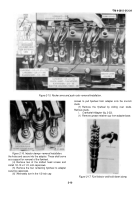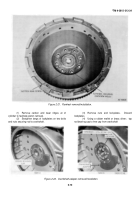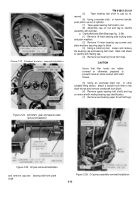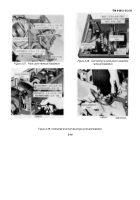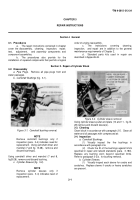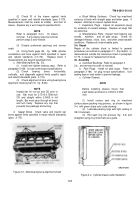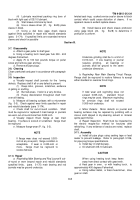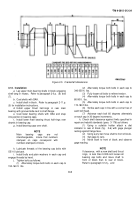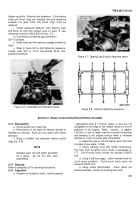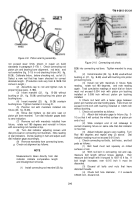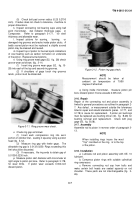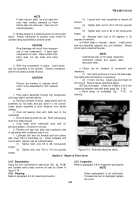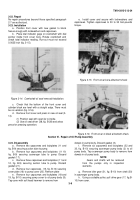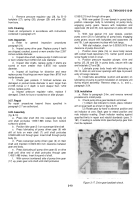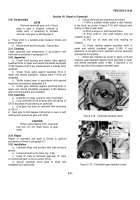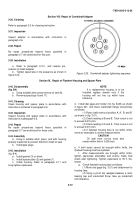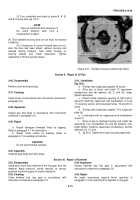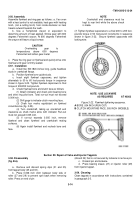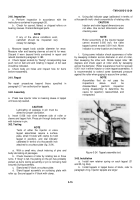TM-9-2815-213-34 - Page 35 of 192
*TM 9-2815-213-34
Figure 3-9.
Piston and ring assembly.
not exceed wear limits shown in repair an build
standards in paragraph 3-178.
f.
Check connecting rod
piston pin and bearing bore alignment,
rod twist,
and
rod centerline (fig.
3-10) in rod checking fixture (40,
fig.
B-28).
Calibrate fixture,
before checking rod,
as foil (1)
Select a new rod that has been checked for correct
absolute length.
(Production rods vary from 8.192/8.194
inches in length.)
(2)
Assemble cap to rod and tighten nuts to
proper torque (para.
3-186).
(3)
Insert mandrel (22,
fig.
B-28) without
bushing or (21,
fig.
B-28) used bushing into piston pin
bushing bore.
(4)
Insert mandrel (20,
fig.
B-28) crankpin
bushing bore.
Tighten mandrel in to snug fit.
(5)
Position rod with mandrels installed into
fixture (40,
fig.
B-28).
(6)
Move dial holders so dial pins seat on
piston pin bore mandrel.
Turn dial indicator gages back
to zero indication.
(7)
Remove rod with mandrels installed from
fixture,
rotate rod 180 degrees and reinstall in fixture
with connecting rod mandrel at top.
(8)
Turn dial indicator adjusting screws until
dial pins seat on connecting rod mandrels.
Note reading
of dial indicators.
Divide reading in half and adjust each
dial indicator gage accordingly.
(9)
Remove mandrels from connecting bores.
g
. Check rod alignment as follows:
NOTE
Measurements taken directly from dial
indicator indicate comparative length
and misalignment of bores.
(1)
Install connecting rod mandrel (20,fig
.
Figure 3-10.
Connecting rod check.
B28) into connecting rod bore.
Tighten mandrel to snug
fit.
(2)
Install mandrel (22,
fig.
B-28) used without
bushing or (21,
fig.
B-28) used with bushing into piston
pin bushing bore.
(3)
Install rod with mandrels in fixture Note
reading,
rotate rod 180 degrees,
and note reading
again.
Total cumulative readings of each dial on fixture
must not exceed 0.004 inch with piston pin bushing
installed or 0.008 inch with-out piston pin bushing
installed.
h.
Check rod twist with a feeler gage between
piston pin mandrel and dial holding plate.
Twist must not
exceed 0.010-inch with bushing installed or 0.020-inch
without bushing.
i.
Check rod centerline as follows:
(1)
Attach dial indicator gage to fixture (fig.
3-
10) so that it will contact the milled surface of piston pin
end of rod.
(2)
Slide crankpin end of rod sideways to
contact checking fixture on same side that dial indicator
is mounted.
(3)
Adjust indicator gage to zero reading.
Turn
Rod 180 degrees and repeat step (2) above.
Dial
indicator reading must not exceed 0.015 inch.
j
. Check connecting rod bolts,
bolt holes,
and bolt
pads as follows:
(1)
Bolt head must rest squarely on milled
surfaces of rod.
(2)
With rod bolt in connecting rod and cap,
measure bolt length without torque applied,
then
measure bolt length with it torqued to 105/115 ft lbs.
If
bolt length increases over 0.015 inch it must be
discarded.
(3)
Discard all bolts and nuts that have
distorted threads.
(4)
Check bolt hole diameter,
if it exceeds
0.5643 inch,
discard rod.
3-6
Back to Top

